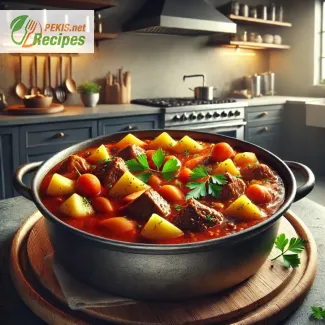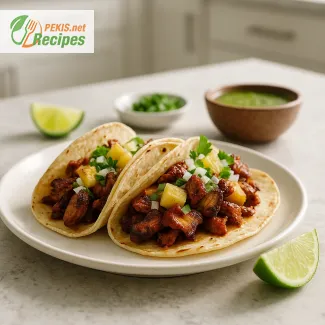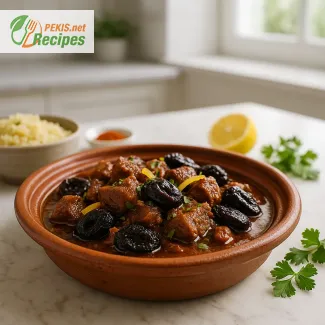
When the days grow shorter and the air turns crisp, there’s no better comfort than a hearty Goulash with Potatoes and Carrots. This traditional dish, rich in both flavor and heritage, has long been a staple across Central and Eastern Europe, providing a satisfying meal that’s perfect for chilly weather. Each spoonful of this goulash embodies warmth, comfort, and the authentic tastes of rustic cuisine, making it an ideal choice for anyone seeking nourishment and coziness as the temperature drops.
Goulash originated as a Hungarian shepherd’s stew, packed with robust ingredients to sustain through long, hard days. While the dish has evolved over time, the essence of goulash remains the same: a stew that’s deeply flavored, generously spiced, and absolutely comforting. The combination of tender potatoes and sweet carrots brings out the natural heartiness of the goulash, while ensuring a balanced, delicious bite every time. This modern take on goulash embraces both tradition and versatility, as it combines simple ingredients with a complex, slow-simmered richness that is unmatched.
Why Potatoes and Carrots Make the Difference
The potatoes add a delightful creaminess that pairs beautifully with the rich, savory broth, while carrots lend a subtle sweetness that balances the spices, enhancing the overall depth of flavor. Together, these ingredients provide a textural contrast that keeps each bite interesting and fulfilling. As they cook down, the potatoes and carrots absorb the stew’s smoky paprika and aromatic herbs, creating a dish that is as flavorful as it is nutritious. This hearty mix not only satisfies hunger but also delivers essential nutrients for warmth and well-being during colder months.
The Heartwarming Power of Paprika and Herbs
At the heart of a traditional goulash is paprika – both smoked and sweet – which gives the stew its distinctive color and warming spice. It’s a spice that does more than just flavor the dish; paprika is known to boost circulation and provide warmth from the inside out. Combined with herbs like thyme, bay leaves, and a touch of cumin, this goulash achieves a fragrant and deeply layered broth, elevating it from a simple stew to a complex culinary experience. These ingredients meld beautifully, creating a savory aroma that fills the kitchen and promises the warmth and comfort of a homemade meal.
A Versatile and Nutritious Choice
Aside from its incredible taste, goulash with potatoes and carrots offers plenty of nutritional benefits. Potatoes provide fiber, potassium, and vitamins, supporting energy and digestive health, while carrots add beta-carotene and antioxidants that help boost immunity. The slow-cooking process ensures that each ingredient has time to fully develop its flavors, resulting in a dish that’s deeply satisfying, from the first bite to the last. Perfect for family meals or gatherings, this goulash can be made in large batches and reheats beautifully, making it a go-to for meal prep and leftover enjoyment.
Perfect for Any Occasion, Loved by All
While goulash is traditionally associated with winter warmth, it is a dish that can be enjoyed any time you crave something wholesome and filling. Its rustic charm and depth of flavor make it an appealing choice for any meal, whether for a quiet family dinner or a larger gathering. Serve it with a slice of crusty bread to mop up the rich broth, or pair it with a crisp green salad for a balanced meal.
In essence, Goulash with Potatoes and Carrots is more than a dish; it’s an invitation to slow down, savor, and indulge in the rich, satisfying flavors of traditional comfort food. Its blend of tender meat, earthy vegetables, and fragrant spices captures the essence of cold-weather cuisine, offering a simple yet refined meal that is both nourishing and memorable. So when the weather calls for warmth, treat yourself to the cozy flavors of a well-made goulash – the kind of meal that warms you from the inside out, leaving you ready to face the winter chill with a full heart and a contented smile.
- Prepare Ingredients: Cut the beef into cubes, dice the onions, mince the garlic, and slice the carrots and potatoes.
- Heat Oil: In a large pot, heat vegetable oil over medium-high heat.
- Sear the Meat: Add beef cubes and sear until browned on all sides. Remove and set aside.
- Cook the Aromatics: In the same pot, add onions and cook until translucent. Stir in garlic and cook for another minute.
- Add Spices: Sprinkle in the sweet and smoked paprika, stirring constantly to avoid burning.
- Combine Meat and Broth: Return the beef to the pot, pour in the beef stock, and add tomato paste, caraway seeds, and bay leaf. Stir to combine.
- Simmer: Bring to a boil, reduce heat, cover, and simmer for about 1 hour until the meat is tender.
- Add Vegetables: Add potatoes and carrots, season with salt and pepper, and continue cooking for another 30-40 minutes or until the vegetables are tender.
- Serve: Garnish with parsley and serve warm.
Tips for Elevating Your Goulash with Potatoes and Carrots Recipe
Goulash with potatoes and carrots is a timeless dish that can be adapted in several ways to enhance its flavor, nutritional profile, and suitability for dietary needs. Here’s how you can elevate this classic recipe into a culinary masterpiece, whether by adding depth of flavor, making it heartier, or customizing it for specific preferences and dietary requirements.
1. Enhancing Depth of Flavor
While the original recipe is already rich and comforting, there are additional ways to intensify the flavors for an even more complex dish:
- Use Beef Bone Broth: Instead of regular beef stock, opt for a bone broth. This not only intensifies the flavor but also adds valuable nutrients like collagen and amino acids. Bone broth gives a richer texture and a deeper, umami taste that complements the goulash's hearty profile.
- Add Red Wine: Adding a splash of dry red wine to the stew base enhances the depth and richness of the broth. Let the wine reduce slightly before adding the stock to avoid a strong alcohol taste, leaving only the concentrated flavors.
- Caramelize the Onions: Instead of just cooking onions until they are translucent, try caramelizing them for a sweeter, more robust flavor. This adds complexity and a hint of sweetness that balances the savory spices.
- Experiment with Paprika: The classic goulash relies on both sweet and smoked paprika, but feel free to explore variations. Hungarian paprika, known for its depth, works particularly well, adding a smoky, slightly spicy undertone. Adjust the quantity to suit your taste, using a bit more smoked paprika for a deeper, earthy profile.
2. Improving the Texture and Consistency
For those who prefer a thicker, stew-like goulash, you can make adjustments to achieve a more substantial texture:
- Thicken the Broth: After cooking, if the goulash seems too watery, you can thicken it by adding a slurry made from cornstarch or flour mixed with water. Stir this mixture into the pot in the last 15 minutes of cooking, and let it simmer until it reaches the desired consistency.
- Mash Some Potatoes: To naturally thicken the stew without additional starch, mash a few pieces of the cooked potatoes directly into the broth. This not only adds creaminess but also retains the dish’s rustic feel.
3. Vegetarian and Vegan Variations
For a plant-based take on goulash, consider the following substitutions that will preserve the dish’s depth and richness:
- Replace Meat with Mushrooms or Tofu: Swap the beef with hearty vegetables like mushrooms or cubed tofu. Mushrooms, especially varieties like portobello or cremini, provide a rich, earthy flavor. Tofu, on the other hand, will absorb the spices and sauces beautifully, adding a satisfying texture.
- Vegetable Broth with Umami Boosters: Instead of beef stock, use vegetable broth, but consider adding a few dashes of soy sauce or miso paste to boost the umami flavor. Soy sauce or miso brings out a savory depth that mimics the richness of a meat-based broth.
- Add Lentils or Chickpeas: For a filling protein source in vegan goulash, add cooked lentils or chickpeas. Lentils, in particular, contribute a slightly nutty flavor that pairs well with the other ingredients, while chickpeas add a creamy texture and protein.
4. Enhancing Nutritional Profile
This dish can be tailored to make it even more nutritious by adding additional vegetables or grains:
- Add Leafy Greens: Spinach, kale, or Swiss chard are great additions to goulash and boost the dish’s fiber and vitamin content. Add them in the last 5-10 minutes of cooking, just enough to wilt them slightly while retaining their nutrients.
- Include More Root Vegetables: Adding root vegetables like parsnips or sweet potatoes can increase the goulash’s vitamin and mineral content while adding natural sweetness. Cut them into small pieces and add along with the potatoes and carrots.
- Top with Fresh Herbs: Fresh herbs, such as parsley, basil, or thyme, add a burst of flavor and additional antioxidants. Parsley, in particular, pairs well with goulash and has high levels of vitamins A, C, and K.
5. Customizing for Dietary Preferences and Restrictions
For those with dietary restrictions, here are ways to adjust the goulash while keeping its rich taste intact:
- Low-Sodium Option: Use a low-sodium broth and reduce the salt added to the recipe. Instead of salt, season the stew with herbs and spices like garlic, thyme, and rosemary to maintain flavor without excess sodium.
- Gluten-Free Adaptation: Traditional goulash is naturally gluten-free, but be cautious when using pre-made broths, which may contain gluten. Opt for a certified gluten-free broth if necessary. If you plan to thicken the stew, use cornstarch or gluten-free flour.
- Low-Fat Option: For a lighter version, replace the beef with a leaner meat like turkey or chicken, or go meat-free with extra vegetables. Use olive oil sparingly, and avoid adding any cream or high-fat ingredients.
6. Flavoring and Spice Variations
To customize the goulash with different flavor profiles, try incorporating various spices or herbs:
- Add Heat with Chili Flakes or Cayenne: For those who enjoy a little kick, add a pinch of chili flakes or cayenne pepper. This enhances the warmth of the dish without overwhelming the traditional flavors.
- Experiment with Herbs like Thyme and Bay Leaves: While bay leaves are a traditional addition to goulash, thyme also works wonderfully with the dish’s flavor profile, adding an earthy note that complements the other ingredients.
- Cumin or Caraway Seeds for Complexity: Both cumin and caraway seeds add a slightly sweet and nutty taste, enhancing the dish’s warmth and making it feel heartier. If you want to deepen the goulash’s flavor, lightly toast these seeds before adding them to the pot.
7. Serving Suggestions
To complete the goulash experience, consider these serving options:
- Serve with Crusty Bread: A slice of crusty bread is perfect for soaking up the rich goulash broth. For a healthier option, choose whole-grain or sourdough bread, which complements the stew’s savory flavors.
- Garnish with Fresh Dairy or Plant-Based Cream: For added creaminess, top the goulash with a dollop of sour cream, Greek yogurt, or a vegan alternative. This adds a slight tanginess, balancing the richness of the stew.
- Side of Spaetzle or Mashed Potatoes: If you prefer a heartier meal, serve the goulash with traditional spaetzle, a type of soft egg noodle, or creamy mashed potatoes. These side dishes provide a satisfying, cozy accompaniment to the stew.
8. Storage and Reheating Tips
Goulash is one of those dishes that tastes even better the next day, as the flavors continue to develop. Here’s how to store and reheat it:
- Storing: Allow the goulash to cool completely, then transfer it to an airtight container. It will keep in the refrigerator for up to 4 days or in the freezer for up to 3 months.
- Reheating: Reheat on the stovetop over low heat, stirring occasionally, until warmed through. If the stew has thickened too much, add a splash of water or broth to reach the desired consistency.
- Freezing: If you plan to freeze goulash, it’s best to do so before adding potatoes, as they can become mushy upon thawing. You can add freshly cooked potatoes when reheating.
With these tips, your Goulash with Potatoes and Carrots can be adapted, elevated, and enriched to suit any taste, diet, or preference, transforming a beloved classic into a customizable, hearty meal perfect for colder days. Whether you’re adding bold spices, enhancing nutritional content, or adjusting textures, these suggestions help turn your goulash into a versatile and satisfying dish that can be enjoyed time and again.
- Allergens: None inherently present in this recipe.
- Gluten: This recipe is gluten-free.
Substitution Tips for Allergies & Gluten:
- If beef stock contains gluten, opt for a certified gluten-free stock.
- For a vegetarian version, replace beef with a mix of mushrooms and lentils, and use vegetable broth.
- Vitamin A: 3800 IU – Supports vision and immune function.
- Vitamin C: 18 mg – Boosts immune system and collagen production.
- Iron: 4.2 mg – Essential for oxygen transport in blood.
- Potassium: 870 mg – Helps maintain healthy blood pressure.
- Magnesium: 28 mg – Supports muscle and nerve function.
- Beta-carotene (from carrots): Supports immune function and skin health.
- Vitamin C (from potatoes and carrots): Combats oxidative stress, enhances iron absorption.
- Flavonoids (from onions): Anti-inflammatory properties and may reduce risk of chronic diseases.





